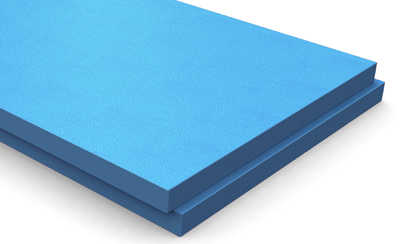General information
Green roofs are a favourable solution both from ecological and technical point of view. The permanent loads arising from the weight of the vegetation layer usually represent only a little additional load as compared to the loads of a traditional terrace roof with normal cladding or a gravel-ballasted flat roof. In return, the benefits offered by nature will move in on the roo
- reduced load on the rainwater drainage system,
- considerable amount of particulate matter bound,
- better heat balance on the roof,
- excellent microclimate,
- considerable carbon dioxide binding ability.
Inverted roofs are excellent for green roofs, and the reliable RAVATHERM XPS is the ideal thermal insulation material for this application as well.
Other information
ADVANTAGES OF GREEN ROOFS
In the design of buildings, it is a more and more important aspect to return as much of the green surface occupied by the building as possible by the assets of architecture. The establishment of green roofs and roof gardens is mainly important in urban environments. Green roofs may mean expanded living space, and contribute to the cleanliness of air and they also have a considerable rainwater-retaining effect. Green roofs have an indirect beneficial effect by relieving the rainwater and wastewater sewerage networks. Inverted roofs have been well-proven for both extensive and intensive green roofs and are a structural solution with long lifespan. The main advantage of the system is providing thermal and mechanical protection against rainwater by the thermal insulation boards.
During the manufacturing of extruded polystyrene (XPS), the result of the extrusion production process is a homogeneous, closed-cell material structure with a smooth surface crust (called extrusion crust) which provides a number of favourable material characteristics:
- persistently high thermal insulation level,
- water and frost resistance,
- high strength,
- high flexible rigidity,
- high resistance to vapour diffusion.
All these favourable characteristics make the XPS thermal insulation material suitable for, among others, the excellent realisation of green roofs.
EXTENSIVE GREEN ROOFS
Extensive green roofs are implemented first of all on the basis of ecological aspects. The roof is usually not used by people for staying. The entire thickness of the layer is not more than 6 to 15 cm. The weight of roofs with the thinnest vegetation blankets are 45 to 60 kg/m2, while thicker ones can be 160 to 250 kg/m2 when wet. In well functioning extensive gardens or roofs, the plantation used have to be well adapted to drought and require little care.
As a topsoil layer, mainly soil mixtures with high water-retention capacity or special mineral substrates acting also as a drain layer can be used. In the case of the latter, there is no need for a separate drain layer, and a thickness of min 6 to 10 mm is recommended. The root network of the contiguous vegetation also provides for the stability required against wind-load, however, along the roof edges and adjoining surfaces additional ballast is necessary, and along the edges and in the neighbourhood of floor gullies gravel ballast strips and surfaces have to be formed in line with the Roof insulation guidelines.
INTENSIVE ROOF GARDENS
Intensive roof gardens are roof gardens with a minimum 30-cm thick plantation soil layer, which may even be identical with the garden in the courtyard of the house. The thickness of the vegetation layer is only restricted by the load-bearing capacity of the roof slab, and, in the case of a 1 to 1.5 m deep soil, even small-sized trees can be planted. Typical forms of roof gardens are gardens for relaxation, children’s playground or parks, but even vegetable gardens can be realised. These kinds of roof gardens are the most valuable roof garden forms. They have the same versatility as a normal garden, so they require regular maintenance, irrigation and appropriate nutrient supply.
Technical
IMPLEMENTATION OF GREEN ROOFS
The material of rainwater proofing of green roofs should be resistant to roots (e.g. FLL certification) otherwise the installation of a separate layer for protection against roots will be necessary. Although the RAVATHERM XPS boards provide additional protection to the waterproofing membrane, they cannot replace protection against roots.
When implementing slope and water drainage, it is an important aspect that SPX boards should not be persistently under water. It is a fundamental design condition that the screed of XPS boards must ensure a slope of at least 2%. (Non-slope roofs have not delivered as expected even when fully protected waterproofing materials, e.g. green roofs, were used!)
In intensive roof gardens, the use of permanently flooded drain layers is to be avoided.
The vapour-permeable layer laid on top of the thermal insulation prevents fine granules to be washed into the drain layer or between the thermal insulation boards, and also provides mechanical protection for the surface of the boards. It is important to build them in every case.
Over the thermal insulation, as a drain layer, a 30 to 40 mm thick washed gravel, crushed stone, expanded clay aggregate or various special products (drain carpets, profiled drain plates etc.), light-weight combined systems may also be used to ensure free departure of migrant vapour through the thermal insulation.
The use of expanded clay aggregate or keramsite as a surface drain helps to efficiently and quickly drain water and also acts as a water storage layer. In this way, the necessary water remains on the roof, but the excess will be drained.
With respect to thermal insulation materials, XPS thermal insulation boards provide in an impeccable solution. In consideration of the highest loads, the appropriate material is at least XPS 300. In normal cases, the boards are to be installed in one layer, in offset bond, the fluted-edge boards with tight joints, in the thickness complying with thermal dimensioning.
In green roofs, irrespective of whether it is an intensive or extensive solution, a topsoil layer with special composition is required, and also the planned vegetation should also be carefully selected.

